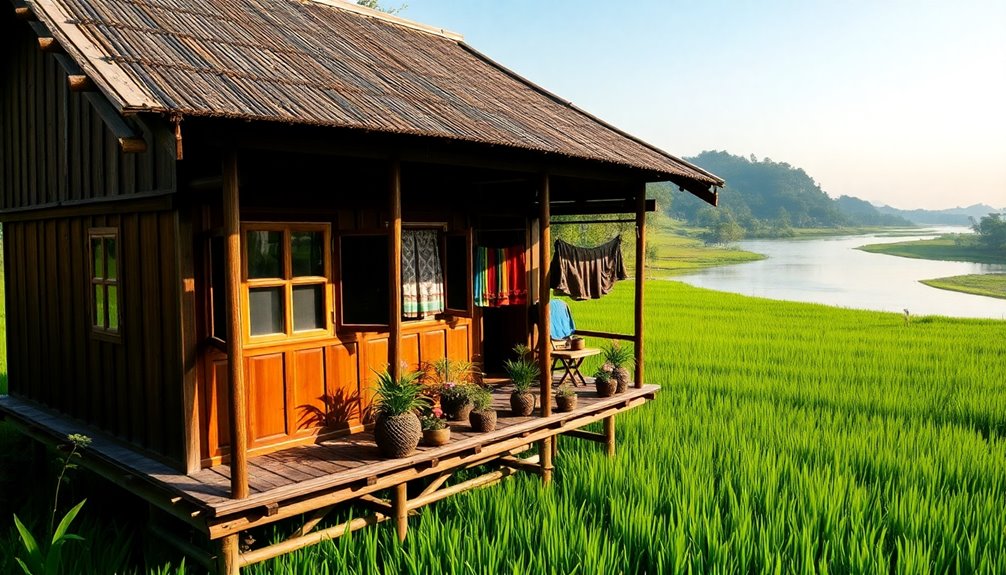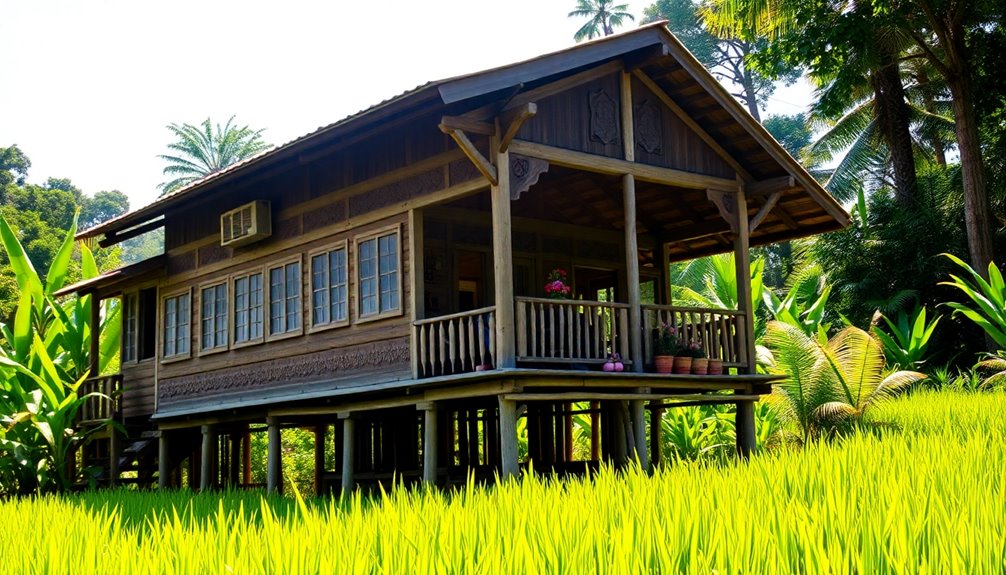When you think of a typical house in Laos, imagine wooden structures elevated on stilts, designed to protect against floods. These homes emphasize family and community with shared living areas and private sleeping spaces. They use local materials like hardwood and bamboo, offering durability and flexibility. Roofs are often inspired by cultural traditions, optimized for seasonal winds. Houses align with cultural beliefs, facing north for good fortune. This architecture reflects the rich heritage and values of the Lao people. To understand the deeper significance and variations across regions, there's much more to explore.
Key Takeaways
- Traditional Lao houses are primarily wooden structures elevated on stilts, designed for ventilation and flood protection.
- Communal living areas symbolize family and community values, while private sleeping quarters offer individual space.
- Roof designs are inspired by Lamvong dance, optimizing airflow and adapting to seasonal weather conditions.
- Houses align with auspicious orientations; facing north symbolizes good fortune, while east-west alignments are culturally avoided.
- Regional variations reflect local traditions and environmental influences, with unique designs from ethnic minorities contributing to cultural diversity.
Overview of Lao Architecture

When you explore Lao architecture, you'll notice that traditional houses, dating from 1910 to 1925, primarily showcase wooden construction tailored to the tropical climate.
These homes often feature a communal living area and private sleeping quarters, divided into two main sections, reflecting the importance of family and community.
Roof designs are inspired by the graceful Lamvong dance, with variations that respond to seasonal winds.
Rituals and customs greatly influence the construction process, emphasizing specific orientations and auspicious numbers to foster prosperity.
While modern adaptations incorporate larger spaces and higher roofs, they still retain key architectural elements that honor Lao cultural heritage.
This blend of tradition and innovation highlights the enduring importance of Lao architecture in everyday life.
Common Materials Used

In Laos, traditional houses rely heavily on local materials that not only support their construction but also reflect the environment.
A typical wooden house often features sturdy hardwood pillars that provide structural integrity and resist moisture damage. You'll find bamboo used for flooring and walls, valued for its lightweight and flexible properties, making it ideal for the tropical climate.
Thatch roofs, crafted from palm leaves or grass, offer excellent natural insulation and can endure seasonal rains and winds.
This choice of materials highlights the essence of traditional architecture in Laos, as homes are aligned along rivers or streams, not only utilizing local resources but also connecting the structure to the surrounding landscape and community.
Design Features and Layout

Laos' traditional wooden houses showcase distinctive design features and layouts that cater to both functionality and cultural values. Elevated on stilts, the Lao House allows for ventilation and protection from flooding, a critical consideration in the region.
The layout typically includes two main sections: a communal living area for family gatherings and a private sleeping area. Traditional Lao architecture features short and long roof designs, optimizing for seasonal winds, while modern adaptations often incorporate higher roofs and more windows for natural light.
These houses face north, with the back oriented south, as the east-west alignment is culturally taboo. Significantly, traditional designs lack indoor toilets, reflecting local practices in rural waste disposal and enhancing the architectural styles unique to Laos.
Cultural Significance of Houses

Houses in Laos aren't just structures; they're lifelong refuges that embody the history, traditions, and values of the Lao people.
Traditional Lao architecture reflects communal living, often dividing spaces to highlight social hierarchies and family dynamics. Each house is a representation of the importance of rituals, with ceremonies conducted to bless new homes, ensuring prosperity for the inhabitants. This connection between architecture and spirituality is essential.
You'll notice that houses typically face north, reflecting cultural beliefs about good fortune, while east-west orientations are avoided due to taboos. The absence of modern amenities like toilets reveals cultural practices surrounding waste disposal, emphasizing community values and respect for the environment.
These elements together weave a rich tapestry of Lao identity and heritage.
Regional Variations in Housing

While exploring the diverse landscapes of Laos, you'll find that traditional housing styles vary considerably across regions, each reflecting the unique cultural and environmental influences at play.
In northern Laos, you'll notice stilt houses made of wood, designed to withstand the mountainous terrain and heavy rainfall.
Central Laos offers wider designs, showcasing a blend of local materials with modern influences.
In southern Laos, particularly around Champasak, Khmer traditions shine through with sandstone structures and intricate carvings.
Ethnic minorities like the Hmong and Khmu add to these regional variations, featuring unique designs that highlight their cultural identities.
Meanwhile, urban areas like Vientiane display modern architecture while still incorporating traditional elements, creating a fascinating mix of old and new in Lao homes.
Frequently Asked Questions
What Is the Traditional Housing in Laos?
Traditional housing in Laos reflects the region's climate and culture.
You'll find wooden structures elevated on sturdy pillars, often featuring eight columns. These homes have spacious terraces for ventilation and communal living areas.
When you explore, notice the roofs designed to withstand strong winds. The absence of toilets in these designs highlights alternative waste practices.
Rituals surrounding construction, like choosing auspicious dates, add a spiritual layer to these unique dwellings.
What Is Housing Like in Laos?
When you think of housing in Laos, you might picture cramped, modern apartments, but the reality is much richer.
Traditional Lao homes are wooden structures, often near rivers, designed for airflow and community. They feature open living spaces where families gather and sleep areas for privacy.
You'll notice unique architectural elements influenced by local customs, with rituals shaping their construction.
Even modern houses retain these cultural touches, blending heritage with contemporary needs beautifully.
What Are the Cultural Norms of Laos?
In Laos, you'll notice strong cultural norms emphasizing respect for elders and community ties.
When greeting others, you might perform the "nop," pressing your palms together while bowing slightly.
Participating in ceremonies like "Baci" is essential for welcoming guests and celebrating events.
Engaging in community activities fosters connections, and Buddhism influences daily life, encouraging compassion and mindfulness.
What Is the Traditional Architecture of Laos?
When exploring traditional architecture in Laos, you'll notice homes primarily built of wood, designed for the local climate.
These structures often feature spacious terraces and effective ventilation systems.
You'll find communal living areas alongside private sleeping spaces, reflecting social hierarchy and community values.
Roof designs cater to seasonal winds, while orientations towards the north hold cultural significance.
Although modern adaptations have emerged, traditional elements still resonate deeply within Lao society's architectural landscape.
Conclusion
In Laos, houses aren't just structures; they're vibrant reflections of culture and community. Picture a stilted home, rising gracefully above the lush landscape, where families gather under the thatched roof, sharing stories and laughter. Each design element carries meaning, echoing the harmony between people and nature. As you explore these unique dwellings, you'll see how every home tells a story, rooted in tradition yet alive with the spirit of the present. Embrace the beauty of Lao living!









